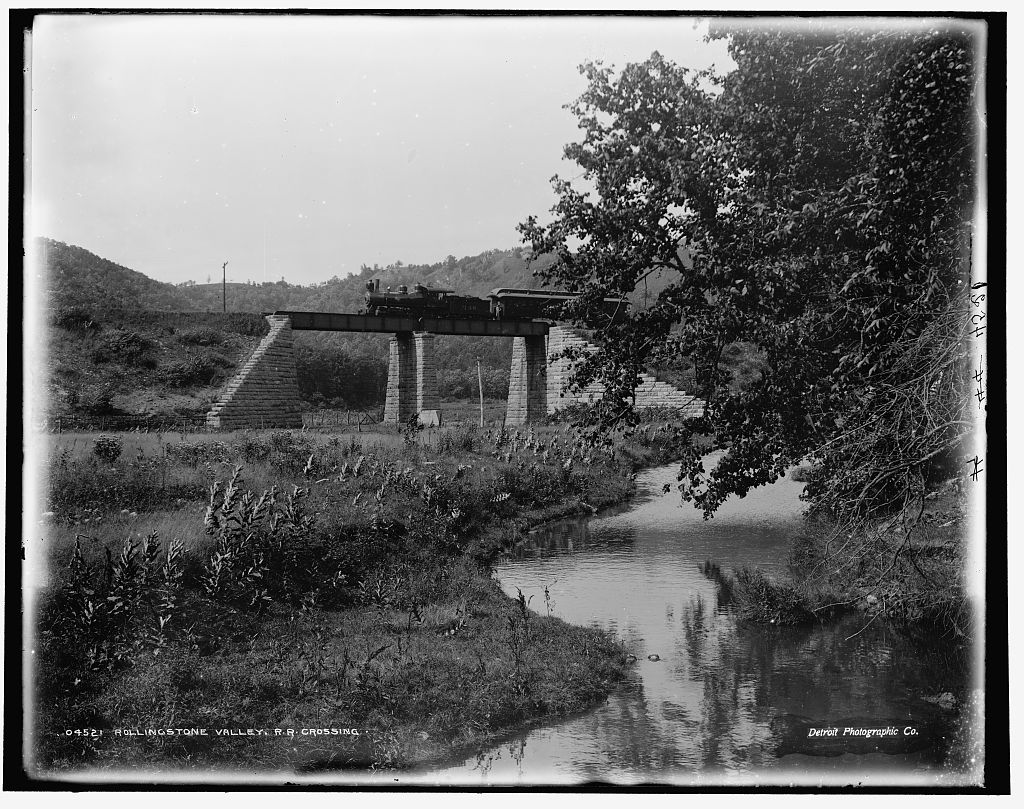- 1864: 50 miles completed from Winona to Rochester, Minnesota by the Winona & St. Peter Railway
- 1865: 55 miles completed from Rochester to Waseca, Minnesota by the Winona & St. Peter Railway
- 1867: W&StP is controlled by the Chicago & North Western Railway
- 1870: 11 miles completed from Waseca to Janesville, Minnesota by the Winona & St. Peter Railway
- 1871: 23 miles completed from Janesville to Mankato, Minnesota by the Winona & St. Peter Railway
- 1872: 30 miles completed from Mankato to New Ulm, Minnesota via St. Peter by the Winona & St. Peter Railway
- 1877: 62 miles completed from New Ulm to Tracy, Minnesota by the Winona & St. Peter Railway
- 1879: 46 miles completed from Tracy, Minnesota to Elkhorn, South Dakota by the Chicago and Dakota Railway
- 1879: 25 miles completed from Elkhorn to Volga, South Dakota by the Dakota Central Railway
- 1880: 184 miles completed from Volga to Pierre, South Dakota by the Dakota Central Railway
- 1881: Chicago and Dakota Railway controlled by the Chicago & North Western Railway
- 1900: 26 miles completed from Mankato to New Ulm, Minnesota by the Mankato & New Ulm Railway
- 1900: The Winona & St. Peter, Chicago and Dakota, Dakota Central and Mankato & New Ulm Railway all are merged into the Chicago & North Western Railway
- 1905: Native American land west of the Missouri River opened to settlement
- 1906: 76 miles completed from Ft. Pierre to Philip, South Dakota by the Pierre, Rapid City & Northwestern Railway
- 1906: 45 miles completed from Rapid City to Wasta, South Dakota by the Pierre, Rapid City & Northwestern Railway
- 1907: 3 miles completed from Pierre to Ft. Pierre, South Dakota by the Pierre & Ft. Pierre Bridge Railway, including the bridge across the Missouri River
- 1907: 44 miles completed from Pierre to Philip, South Dakota by the Pierre, Rapid City & Northwestern Railway
- 1907: Pierre, Rapid City & Northwestern and the Pierre & Ft. Pierre Bridge Railway controlled by the Chicago & North Western Railway
- 1937: Burdette to Kasota segment abandoned
- 1957: Kasota to St. Peter segment abandoned, and Minnesota River Bridge removed
- 1963: St. Peter to Traverse segment abandoned
- 1970: Traverse to New Ulm Quarry segment abandoned
- 1986: Winona to Rapid City route, and New Ulm Quarry spur sold to Dakota, Minnesota & Eastern Railroad amid C&NW abandonment proposals
- 2008: DM&E purchased by Canadian Pacific Railway and operated as a subsidiary
- 2014: CP sells Tracy, Minnesota to Rapid City, South Dakota to Genesee Wyoming owned Rapid City, Pierre & Eastern Railroad
- 2008-Present: Canadian Pacific (DM&E) operates the Winona to Waseca segment as the Waseca Subdivision
- 2008-Present: Canadian Pacific (DM&E) operates the Waseca to Tracy segment as the Tracy Subdivision
- 2014-Present: Rapid City, Pierre & Eastern operates the Tracy to Huron segment as the Huron Subdivision
- 2014-Present: Rapid City, Pierre & Eastern operates the Huron to Pierre segment as the Pierre Subdivision
- 2014-Present: Rapid City, Pierre & Eastern operates the Pierre to Rapid City segment as the PRC Subdivision
12/03/21
This standard deck plate girder bridge crosses Garvin Brook near a more significant bridge, The Arches.
However, this structure is also worthy of some attention. Situated in a spot where deck girders likely would not normally be used, the bridge is supported by stone substructures and a notable massive center pier.
A normal bridge of this length may be a small through truss of types, but instead the railroad opted to build a two span deck girder here.

Historic photo of the previous bridge. Library of Congress photo
The bridge appears to retain an excellent historic integrity. It was part of a number of structures to be built through the area during this time.
The bridge has been ranked as locally significant, because it is a smalltime landmark to the area. In addition, the features of massive stone substructures add an interesting feature to an otherwise common bridge.
The photo above is an overview.
